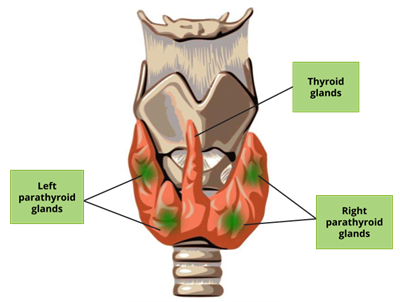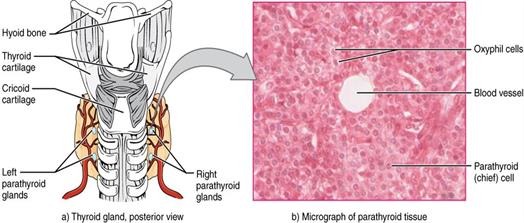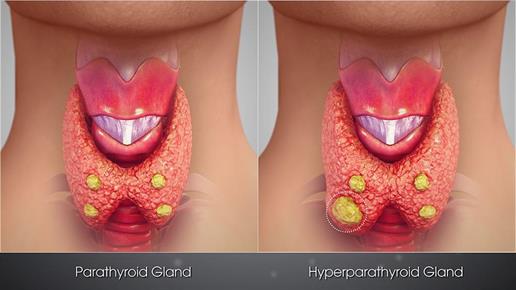
PUMPA - SMART LEARNING
எங்கள் ஆசிரியர்களுடன் 1-ஆன்-1 ஆலோசனை நேரத்தைப் பெறுங்கள். டாப்பர் ஆவதற்கு நாங்கள் பயிற்சி அளிப்போம்
Book Free DemoCalcium helps our blood clot, muscles contract, and heartbeat in addition to developing and maintaining healthy bones. The functions mentioned above are done through the metabolism of calcium. This metabolism is controlled by a hormone called parathyroid hormone.
Parathyroid gland
Parathyroid glands originate from the embryo's endoderm. These glands are made up of four separate glands positioned on the posterior aspect of the thyroid glands lobes.

Posterior view of parathyroid glands
The cells of the parathyroid glands are arranged in a compact mass and are of two types:
- Small chief cells or principal cells
- Large oxyphil cells or eosinophil cells

Oxyphil and chief cells
The chief cell of parathyroid gland produces a hormone known as parathormone. It is also called Collip's hormone.
Function:
This hormone helps to regulate the metabolism of calcium and certain other minerals like phosphate.
Hypoparathyroidism (Deficiency of parathormone)
Hypoparathyroidism decreases the calcium level in the blood. Due to this, nerves and muscles become more excitable, sustained contractions (tetany) of the larynx muscles, face, hands, and feet occur. The condition is known as parathyroid tetany.
Parathyroid and Hyperparathyroid gland
Hyperparathyroidism (excess of parathormone)
Hyperparathyroidism is a condition in which the thyroid gland produces too much (excess of parathormone). Because one of the consequences of parathormone is the destruction of bone (osteoporosis), bones become soft. Some of the bone substance is replaced by fibrous connective tissue when there is an excess hormone.
An excess of parathormone also causes calcium deposits in the kidneys. The content of kidney stones can occasionally indicate the presence of a parathyroid tumour.
In previous chapters, you might have studied the production of Lymphocytes from bone marrow which plays a significant role in the human immune system.
Due to its significance in the immune system, it is called the primary lymphoid organ. But, besides bone marrow, there is another gland called the primary lymphoid organ. This gland is called the thymus, which also helps in the production of lymphocytes.
Thymus
Location:
The thymus is originated from the embryo's endoderm. It is located on the dorsal (ventral) side of the heart and aorta.

Diagram showing the position of the thymus gland
Structure and nature
It is a bilobed mass of lymphoid tissue that's soft and pinkish. It is a prominent gland at birth, but as an adult, it gradually atrophies.

The structure and histology of the thymus
Function
The thymus is an essential part of the immune system's development. Hassalloe's cells are phagocytic cells found in the thymus. Thymosins, peptide hormones secreted by the thymus, are crucial in the development of T-lymphocytes. T-lymphocytes provide cell-mediated immunity.
Thymosin also stimulate antibody synthesis, which provides humoral immunity.

Thymus: Lymphoid organ
Note: In older people, the thymus degenerates, resulting in a decrease in thymosin production. Hence, older people's immune systems weaken.
Reference:
https://commons.wikimedia.org/wiki/File:1814_The_Parathyroid_Glands.jpg
https://upload.wikimedia.org/wikipedia/commons/thumb/4/45/3D_Medical_Animation_still_shot_Hyperparathyroidism.jpg/1024px-3D_Medical_Animation_still_shot_Hyperparathyroidism.jpg
https://upload.wikimedia.org/wikipedia/commons/thumb/4/45/3D_Medical_Animation_still_shot_Hyperparathyroidism.jpg/1024px-3D_Medical_Animation_still_shot_Hyperparathyroidism.jpg
https://upload.wikimedia.org/wikipedia/commons/3/37/Diagram_showing_the_position_of_the_thymus_gland_CRUK_362.svg
https://upload.wikimedia.org/wikipedia/commons/9/99/2206_The_Location_Structure_and_Histology_of_the_Thymus.jpg